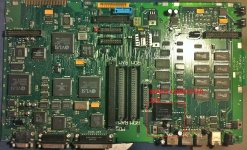uniserver
Well-known member
has anyone done any more work on these Back-Lit Models?
for instance what is: and kindly what are the proper values?
VR1
Q1
Q15
Q16
Q20
IS U5L Voltage Regulator Replaceable?
U2L - Voltage Ref?
What are common issues with these?
For instance, what part would allow the hard drive to spin up solely from battery? Q16?
I'v got 2 back-lit boards here that are both acting funny when (only) running off a good SLA battery.
When plugged in both boards work flawlessly.
Please lets expand this thread with good complete info, I am sure there are some back-lit owners that could find this information very useful, looks like technight has a good start.
I can hodge podge something together, so i can get my multimeter on some of these parts to see what the values are, my only issue is, I do not have a properly working back-lit portable board for a base-line.
for instance what is: and kindly what are the proper values?
VR1
Q1
Q15
Q16
Q20
IS U5L Voltage Regulator Replaceable?
U2L - Voltage Ref?
What are common issues with these?
For instance, what part would allow the hard drive to spin up solely from battery? Q16?
I'v got 2 back-lit boards here that are both acting funny when (only) running off a good SLA battery.
When plugged in both boards work flawlessly.
Please lets expand this thread with good complete info, I am sure there are some back-lit owners that could find this information very useful, looks like technight has a good start.
I can hodge podge something together, so i can get my multimeter on some of these parts to see what the values are, my only issue is, I do not have a properly working back-lit portable board for a base-line.


